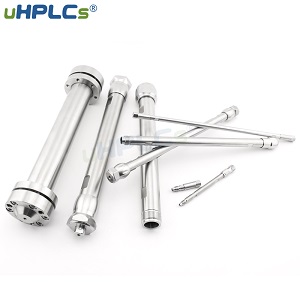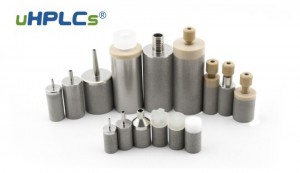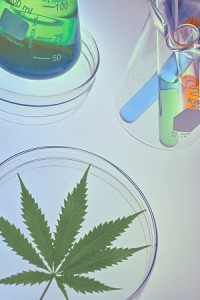A good separation is closely related to the accuracy of the quantification. “Yesterday’s separation was not very good. The mobile phase needs to be adjusted again!” Does this sound familiar? Adjustment? How? If you don’t know how to prepare a suitable mobile phase, please take a look! Today, I have compiled a list of knowledge on improving peak shape and separation in the liquid phase for your reference only.
Tip 1: Strong to weak generally starts with 90% acetonitrile (or methanol)/water (or buffer solution) so that separation results can be obtained quickly. Then the proportion of organic solvent (acetonitrile or methanol) is adjusted according to the peak emergence.
Tip 2: The rule of thirds For every 10% reduction in organic solvent (methanol or acetonitrile), the retention factor increases by approximately 3. This is known as the rule of thirds. This is a clever and labour-saving approach. During the adjustment, watch the separation of the individual peaks.
Tip 3: Coarse adjustment to fine adjustment When the separation has reached a certain level, the 10% change in the organic solvent should be adjusted to 5%, and the adjustment rate should be gradually reduced according to this rule until the separation of the components no longer changes.
Solutions:
1, the nature of the mobile phase requires an ideal liquid chromatography mobile phase solvent that should have low viscosity, good compatibility with the detector, easy-to-obtain pure products, low toxicity, and other characteristics. The following aspects should be considered when selecting the mobile phase:
① The mobile does not change any filler properties. Ion-exchange resins and exclusion chromatography fillers with low cross-linkage sometimes swell or shrink when they encounter certain organic phases, thus changing the properties of the column’s packed bed. Alkaline mobile phases cannot be used in silica column systems. Acid-mobile phases should not be used in column systems with adsorbents such as alumina and magnesium oxide.

②Purity. The lifetime of a HPLC column is related to the passage of a large amount of mobile phase, especially when impurities in the solvent accumulate on the column.
③ Must be matched to the detector. When using a UV detector, the mobile phase should have no or very little absorption at the detection wavelength. When using a differential refractive index detector, a solvent with a refractive index that differs significantly from the sample should be selected as the mobile phase to improve sensitivity.
④ The viscosity should be low (should be <2cp). High-viscosity solvents can affect solute diffusion and mass transfer, reduce column efficiency, and increase the column pressure drop, reducing separation time. It is best to choose a mobile phase with a boiling point below 100°C.
⑤ The solubility of the sample should be appropriate. If the solubility is poor, the sample will precipitate at the head of the column, which not only affects the purification separation but also deteriorates the column.
⑥The sample is easy to recover. A volatile solvent should be used.
2, pH of mobile phase When using reversed-phase chromatography to separate weak acids (3 ≤ pKa ≤ 7) or weak bases (7 ≤ pKa ≤ 8) samples, the technique of adjusting the pH of the mobile phase to inhibits the dissociation of the sample components, increase the retention of the components on the stationary phase and improve the peak shape is called reversed-phase ion suppression technique. For weak acids, the lower the pH of the mobile phase, the greater the k-value of the component. When the pH is much less than the pKa value of the weak acid, the weak acid is mainly present in molecular form; for weak bases, the opposite is true. When analyzing weak acid samples, a small amount of weak acid is usually added to the mobile phase, commonly 50 mmol/L phosphate buffer and 1% acetic acid solution; when analyzing weak base samples, a small amount of weak base is usually added to the mobile phase, commonly 50 mmol/L phosphate buffer and 30 mmol/L triethylamine solution.
Note: Adding organic amines to the mobile phase can weaken the strong interaction between the basic solute and the residual silanol group, reducing or eliminating the peak-dragging phenomenon. So, in this case, the organic amine (e.g. triethylamine) is also called a tailing reducer or a tailing remover. (Triethylamine is the product of the substitution of the hydrogen atom in the ammonia molecule by 3 ethyl groups. Molecular formula (CH3CH2)3N. Volatile colorless liquid with an ammonia odor. Melting point -114.7°C, boiling point 89.3°C, relative density 0.7275 (20/4°C). Soluble in water and organic solvents such as ethanol and ether. Triethylamine is alkaline and can be used with inorganic acids to produce soluble salts in water. It can be produced by reacting N, N-dimethylacetamide with lithium aluminum hydride and synthesized by gas phase alkylation with ethanolamine. It is used as a rubber vulcanization accelerator, wetting agent, and fungicide, as a solvent, and in synthesizing quaternary ammonium compounds).
3, how to choose the buffer PH value in the choice of buffer PH value before, should first understand the analyte Pka, higher or lower than Pka two PH value units, help to obtain a good, sharp peak, from the HH formula: PH = Pka + log ([A-]/[A]) know that the solution PH value higher or lower than Pka two units, 99% of the compound in one form, and A compound present in one form is the only one that gives a good sharp peak. It shows its ionic form and the shift to the neutral compound. Pka for benzoic acid is equal to 4.2. Theoretically, it is known from the HH metric that 99% of the benzoic acid is present as a neutral compound when the solution PH is equal to 2.2, and 99% of the benzoic acid is present in the ionic form when the PH is equal to 6.2, so when the buffer PH is equal to 2.2, the neutral compound is retained in the reversed-phase column in the carboxylic acid form. When the compound is only amino, the choice of the buffer system is straightforward. Most amino compounds are protonated at pH values less than 9, so all solutions with a pH value of 7 or lower are suitable for the application. Any buffer can be used for the analysis of amino compounds. Still, we believe that a potassium phosphate salt with a pH equal to 3 is most suitable for analyzing amino compounds.
In the above two examples, PH = 3 potassium phosphate salt can be applied well. Generally, it is the best buffer for analyzing compounds containing carboxyl and amino groups. In the analysis of amino compounds, the potassium salt is better than sodium salt.
4, the mobile phase degassing HPLC mobile phase must be pre-degassed. Otherwise, it is easy to escape in the system bubbles, affecting the work of the pump. Air bubbles will also affect the column’s separation efficiency, affecting the detector’s sensitivity and baseline stability and making it impossible to detect. (Increased noise, unstable baseline, sudden jumps). uHPLCs recommends that you use our bubble-free suction filter, which can avoid the generation of bubbles

In addition, oxygen dissolved in the mobile phase may react with the sample, the mobile phase, or even the stationary phase (e.g. alkylamines). Dissolved gases can also cause changes in solvent pH, introducing errors in the separation or analytical results. Dissolved oxygen can form UV-absorbing complexes with certain solvents (e.g. methanol, tetrahydrofuran). This complex can increase the background absorption (especially below 260 nm) and cause a slight decrease in detection sensitivity. More importantly, it can cause baseline drift or the formation of ghost peaks (false peaks) during gradient drenching. In fluorescence detection, dissolved oxygen can also cause quenching under certain conditions, particularly for aromatic hydrocarbons, aliphatic aldehydes, ketones, etc.
In some cases, the fluorescence response can be reduced by up to 95%. In electrochemical detection (especially in reduction electrochemistry), the effect of oxygen is even greater. Removal of dissolved oxygen from the mobile phase will greatly improve the UV detector’s performance and sensitivity in some fluorescence detection applications. Common methods of degassing include heating and boiling, evacuation, ultrasonication, and helium blowing. For mixed solvents, if evacuation or boiling is used, the change in composition caused by volatilization of the lower boiling point solvent needs to be considered. Ultrasonic degassing is better, 10-20 minutes of ultrasonication is sufficient for many organic solvents or organic solvent/water mixtures (generally, 500ml of solution requires 20-30min of ultrasonication before), and this method does not affect the solvent composition. Care should be taken when sonicating to avoid contact between the solvent bottle and the bottom or wall of the sonication tank to avoid breakage of the glass bottle and not to raise the liquid level in the container too much above the water level. The off-line (off-system) degassing method does not maintain the solvent in a degassed state, and the gas returns to the solvent immediately after you stop degassing. Within 1 to 4 hours, the solvent will again be saturated with ambient gas.
In-line (in-system) degassing does not have this disadvantage. The most commonly used in-line degassing method is bubbling, where an inert gas is sprayed into the solvent before and while the chromatography operation is in progress. Strictly speaking, this method does not degas the solvent. It replaces the air with a low-solubility inert gas (usually helium). In-line degassers are also available. Generally speaking, the gases in organic solvents are easy to remove, while those in aqueous solutions are more stubborn. Blowing helium into the solution is a fairly effective method, and this continuous method is often used in electrochemical testing. However, helium is expensive and challenging to popularise.

All solvents must be filtered through 0.45µm (or 0.22µm) to remove impurity particles before use, and chromatographically pure reagents are no exception (unless labeled as “filtered”). When filtering with membranes, special care must be taken to distinguish between organic (fat-soluble) and aqueous (water-soluble) phase membranes. Organic phase membranes generally filter organic solvents and do not filter aqueous solutions at low flow rates or without filtration.
Aqueous membranes should only filter aqueous solutions, not organic solvents. Otherwise, the membrane will be dissolved! Solvents dissolved in the membrane should not be used for HPLC.
The membranes can be filtered separately before mixing for mixed mobile phases, but organic phase membranes are preferred for post-mixing filtration. Hybrid membranes are now available for sale. Storage of mobile phase The mobile phase is generally stored in glass, PTFE, or stainless steel containers and cannot be stored in plastic containers. Many organic solvents, such as methanol and acetic acid, can leach plasticizers from the surface of plastics, contaminating the solvent. Such contaminated solvents may cause a reduction in column efficiency if used in HPLC systems. Storage containers must be tightly covered to prevent changes in composition due to solvent evaporation and to prevent oxygen and carbon dioxide from dissolving into the mobile phase. Phosphate and acetate buffers are susceptible to mold growth and should be prepared as fresh as possible and not stored. If storage is necessary, it should be refrigerated, used within 3 days, and re-filtered before use. Containers should be cleaned regularly, especially bottles containing water, buffers, and hybrid solutions, to remove any impurities at the bottom and any microorganisms that may have grown. This is not the case for methanol bottles because of their antiseptic effect.
6, halogenated organic solvents should pay special attention to the issue of halogenated solvents may contain traces of acidic impurities that can react with the stainless steel in the HPLC system. Halogenated solvents and water mixtures are relatively easy to decompose and can not be stored for too long. Halogenated solvents (e.g. CCl4, CHCl3, etc.) mixed with various ethers (e.g. ether, diisopropyl ether, tetrahydrofuran, etc.) may react to produce some products that are more corrosive to stainless steel, and such mixed flows should accordingly be avoided as far as possible, or freshly prepared.
In addition, halogenated solvents (such as CH2Cl2) and some reactive organic solvents (such as acetonitrile) produce crystallization when mixed with standing. In short, halogenated solvents are best used freshly prepared. Similar problems do not arise if they are mixed with dry saturated alkanes.
Post time: Jan-05-2023






